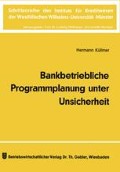Zusammenfassung
Das Ziel der Liquiditätssicherung hat sich zu einem zentralen Problem der Bankbetriebslehre entwickelt. Es sind eine Vielzahl von Dispositionsregeln geschaffen worden, bei deren Beachtung die Zahlungsfähigkeit stets gewährleistet sein soll und die daher die Grundlage bilden für Optimierungsmodelle zur Ableitung gewinnmaximaler Handlungsprogramme. Allerdings hat sich die Ansicht, wie der Bankleiter handeln soll, um dem Ziel der Liquiditätssicherung zu genügen, im Laufe der Zeit erheblich gewandelt.1
Access this chapter
Tax calculation will be finalised at checkout
Purchases are for personal use only
Preview
Unable to display preview. Download preview PDF.
Literatur
Mülhaupt, L., Die Goldene Bankregel und ihre Problematik, in: Der langfristige Kredit, 22. Jg. (1971), S. 35 ff.;
Braun, W., Das Liquiditätsproblem der Kreditbanken, Stuttgart 1934;
Hercog, F., Liquidität und Liquiditätspolitik der Kreditbanken, Petrovgrad 1935;
Sturm, V., Der Wandel der Auffassungen über die Liquidität der Kreditbanken, Diss. Frankfurt a.M. 1947;
Hintner, O., Zum Liquiditätsproblem der Geschäftsbanken, in: Der Betrieb in der Unternehmung, Festschrift für Wilhelm Rieger zu seinem 85. Geburtstag, Hrsg. J. Fettel und H. Linhardt, Stuttgart 1963, S. 396 ff.;
Hoffmann, H., Dispositionsregeln zur Solvenzsicherung von Depositenbanken, Diss. Saarbrücken 1967;
Gide, U., Giroeinlagen der Sparkassen, in: Sparkasse, 86. Jg. (1969), S. 269 ff.;
Hagenmüller, K.-F., Der Bankbetrieb, Bd. III, a.a.O., S. 346 ff.
Hübner, 0., Die Banken, Leipzig 1854, S. 28.
Wagner, A., Beiträge zur Lehre von den Banken, Leipzig 1857.
Keynes, J.M., General Theory of Employment, Interest and Money, London 1936, S. 165 ff. und S. 194 ff.
Wagner, A., Beiträge zur Lehre von den Banken, a.a.0., S. 167.
Knies, K., Geld und Credit, II. Abt., 2. Hälfte, Der Credit, Neudruck Leipzig 1931, S. 242.
Vgl. etwa Reed, E.W., Commercial Bank Management, New York-Evanston-London 1963, S. 180;
Crosse, H.D.i Management Policies for Commercial Banks, Englewood Cliffs, N.J. 1963. S. 195 ff.;
Selhausen, H., Die Optimalplanung von Kapitalbeschaffung und Kapitalverwendung einer Kreditbank mit den Methoden der Unternehmensforschung, Köln o.J. (1970), S. 114 ff.;
Chambers, D./Charnes, A., Inter-Temporal Analysis and Optimization of Bank Portfolios, in: Analytical Methods in Banking, Hrsg. K.J. Cohen/ F.S. Hammer, a.a.O., S. 67 ff.
Vgl. Mülhaupt,L./Küllmer,H., Probleme der Entscheidungsfindung im Bankbetrieb, in: Kredit und Kapital, 4. Jg. (1971), S. 177 f;
Scheidl, K., Zum Problem bankbetrieblicher Dispositionsregeln, in: Dienstleistungen in Theorie und Praxis, Hrsg. H. Linhardt/P.Penzkofer/P. Scherpf, Stuttgart 1970, S. 175 ff.
Gleske, L., Die Liquidität in der Kreditwirtschaft, Frankfurt a.M. o.J., S. 12.
Macleod, H.D., a.a.O., S. 594; Hahn, A.L., a.a.O., S. 44.
Bereits 1915 wurde von Harris eine Formel für die Losgröße entwickelt;
Harris, F.W., Operation and Costs ( Factory Management Series ), Chicago 1915;
Kottke, E., Die optimale Beschaffungsmenge, Berlin 1966, S. 79;
Whitin faßte die Entwicklung bis 1952 zusammen und ergänzte sie durch eigene Beiträge;
Whitin, T.M., The Theory of Inventory Management, Princeton 1953;
Churchman, C.W./Ackoff R.L./Arnoff,E.L., Opera-tions Research, Eine Einführung in die Unternehmensforschung, Wien-München 1961;
Popp, W., Einführung in die Theorie der Lagerhaltung, Berlin-HeidelbergNew York 1968;
Hochstädter, D., Stochastische Lagerhaltungsmodelle, Berlin-Heidelberg-New York 1969.
Vgl. Kuhn, A., Zum Problem der optimalen Bestellmenge, Diss. Münster 1964, S. 4.
Baumol, W.J., The Transactions Demand for Cash: An Inventory Theoretic Approach, in: QJoE, Vol. 66 (1952), S. 545 ff.;
Tobin, J., The Interest-Elasticity of Transactions Demand for Cash, in: The Review of Economics and Statistics, Vol. 38 (1956), S. 241 ff.;
Orr, D./ Mellon, W.G., Stochastic Reserve Losses and Expansion of Bank Credit, in: AER, Vol. 51 (1961), S. 614 ff.;
Morrison, G.R.L Liquidity Preferences of Commercial Banks, Chicago-London 1966, S. 8 ff.;
Jarchow, H.-J., Theoretische Studien zum Liquiditätsproblem, a.a.0., S. 11 ff.;
Miller, M.H./Orr, D., A Model of the Demand for Money by Firms, in: QJoE, Vol. 80 (1966), S. 413 ff.;
dieselben, An Application of Control-Limit-Models to the Management of Corporate Cash Balances, in: Financial Research and Management Decisions, Hrsg. A.A. Robichek, New York-London-Sydney 1967, S. 113 ff.;
dieselben, The Demand for Money by Firms: Extensions of Analytic Results, in: JoF, Vol. 23 (1968), S. 735 ff.;
Whalen, E.L., A Rationalization of the Precautionary Demand for Cash, in: QJoE, Vol. 80 (1966), S. 314 ff.;
Eppen, G.D./Fama,E.F., Solutions for Cash-Balance and Simple Dynamic-Portfolio Problems, in: JoB, Vol. 41 (1968), S. 94 ff.;
Sprenkle, C.M., The Uselessness of Transactions Demand Models, in: JoF, Vol. 24 (1969), S. 835 ff.; Tsiang, S.C., a.a.0., S. 99 ff.;
Sastry, R.A.S., The Effect of Credit on Transactions Demand for Cash, in: JoF, Vol. 25 (1970), S. 777 ff.;
Neave, E.H., The Stochastic Cash Balance Problem with Fixed Costs for Increases and Decreases, in: MS, Vol. 16 (1970), S. 473 ff.;
Orgler, Y.E. An Unequal-Period Model for Cash Management Decisions, in: MS, Vol. 16 (1970), S. 77 ff.
Rights and permissions
Copyright information
© 1975 Betriebswirtschaftlicher Verlag Dr. Th. Gabler, Wiesbaden
About this chapter
Cite this chapter
Küllmer, H. (1975). Die Planung der Barreserve des Bankbetriebs. In: Bankbetriebliche Programmplanung unter Unsicherheit. Schriftenreihe des Instituts für Kreditwesen der Westfälischen Wilhems-Univerität Münster, vol 16. Gabler Verlag, Wiesbaden. https://doi.org/10.1007/978-3-322-88010-9_6
Download citation
DOI: https://doi.org/10.1007/978-3-322-88010-9_6
Publisher Name: Gabler Verlag, Wiesbaden
Print ISBN: 978-3-409-42044-0
Online ISBN: 978-3-322-88010-9
eBook Packages: Springer Book Archive

